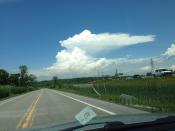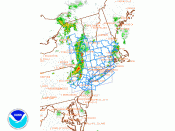Casey Flynn Flynn 1
Mr. Maloney
Earth Science
4 April 2004
Meteorological Disaster Research Paper
Meteorological Disasters are a byproduct of the Earth's atmospheric and oceanic attempts to balance heat energy uniformly throughout the planet. An example of a common meteorological disaster is thunderstorms. Thunderstorms are storms that entail lightning and thunder, created by a cumulonimbus cloud, that normally produce intensive winds, heavy rainfall, and on occasion hail. On average they reach about 15 miles in diameter and last for 30 minutes. 100,000 thunderstorms form over the continental United States per year and 10% are classified as "severe". There are 1,800 thunderstorms at any given moment globally. Despite popular belief, lightning is not the primary killing element of a thunderstorm. Flash flooding is the most potent product of a thunderstorm, killing on average over one-hundred-forty people per year. Tornadoes that come with thunderstorms are responsible for an average seventy deaths, and 1,500 injuries a year.
Severe winds can be a serious threat to aircraft and are capable of producing damage equal to that of a tornado. (National Weather Service)
In order for a thunderstorm to form several conditions must be present. Moisture is necessary for the formation of clouds and rain. The presence of unstable air, or warm air capable of rising rapidly, is also required. And finally a lift factor must be included, such as a cold or warm front, sea breezes, and mountains, to lift the unstable hair to a higher altitude where it will cool and condense. If these three elements are present under the right conditions then a thunderstorm will be set in motion with the first of three stages, the developing stage. The developing stage is where warm, moist air is pushed
Flynn 2
upwards by the lift force. During this stage there...


